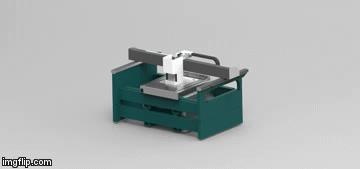ADIRA may not be a name familiar to many in the 3D printing industry. With a 60 year history, the Portuguese company is more widely known in the sheet metal processing sector for it’s range of Press Brakes, Shears and Laser Cutting Systems.
ADIRA first launched an additive manufacturing system at the 2016 edition of EuroBLECH. Visitors to formnext 2017 saw how that concept from last year had developed over the following 12 months. One of the parts demonstrated during the Frankfurt trade show was a bladed turbine disk.

I asked Filipe Coutinho, Product Development Engineer AM team member at ADIRA, a few questions about the AddCreator metal 3D printing system.
“a change in the paradigm of Powder-bed Fusion processes”
The AddCreator on display during formnext 2017 was boldly announced as The World’s Largest Metal Part Printer. “We currently have a work volume of 1000x1000x500 mm, which could imply the production of parts up to 0.5 cubic meters,” explains Coutinho. “Nevertheless, our process is scalable in every direction (something exclusive to the current market), making it possible to scale the process to the requirements of the user.”
ADIRA’s AM system was under development for the past 2 years and uses a technology the company call Tiled Laser Melting, it is based on a powder-bed fusion (PBF) system.
In contrast to other metal PBF 3D printers, the AddCreator has a segmented build chamber, and this is key to producing larger parts. “The build chamber, unlike other solutions currently on the market, is moveable and modular,” says Coutinho. “This means that we move it around the powder bed area during the process, instead of keeping it at one fixed location.”
In short, we create the powder layers in the conventional way, however we process them in smaller segments, specifically 250×250 mm tiles. After the layer is set, we move the process chamber over the powder bed and we scan the required areas for that same layer, afterwards moving it outside of the working area for the deposition of a new one.
The principle is the same for larger parts, dividing them in smaller segments. “By using proprietary scanning strategies, we are able to overlap scan fields and guarantee the correct “stitching” of the solid volume (in the end resulting in one single part).”
Coutinho describes this as “a change in the paradigm of Powder-bed Fusion processes, which up until now resorted to fixed scanning systems over a fixed area for processing.”
The photo of the 900mm long conceptual cooling nozzle below illustrates the potential for large horizontal work.

Aerospace, Automotive and integration with industry
The ADIRA AddCreator currently uses non-reactive metals, with development work focused on parameter sets for steel alloys. Work is underway to create further settings that allow 3D printing with other alloys including Inonel, and possibly Cobalt-Chrome. Reactive metals, including aluminum and titanium are a further objective.
An early supporter of the AddCreator is Poly-Shape, an additive manufacturing service bureau based in France. Poly-Shape will be the first customer for the AddCreator.
Coutinho says other “innovative added-value segments as well as the more conventional heavy-duty industry” are also addressable markets. This includes the Aeronautical industry who are “looking for large-part manufacturing through AM when it comes to satellite antenna frames, for example, large weight-reducing structures.”
In the Automotive sector the AddCreator may have application, “targeting bio-frames as a way to reduce weight and the amount of parts needed for assembly.
Furthermore, integration with more traditional industrial processes such as injection molding is envisioned. “The molding industry is looking for ways to incorporate large inserts with conformal cooling and heating channels, reducing the cycle time for plastic injection and improving the return on investment,” says Coutinho.

The first system developed by ADIRA uses 400W lasers, but this can be increased if a customer requires. Furthermore, because the Tiled Laser Melting process is scaleable, ADIRA has “flexibility in developing special tailor-made solutions for its customers,” when it comes to build volume specifications also.
The AddCreator is likely to be joined by other 3D printing systems from ADIRA in the future.
More information about the ADIRA AddCreator is available here.
For all the latest additive manufacturing news, subscribe to our free 3D Printing Industry newsletter, follow us on Twitter, and like us on Facebook.



